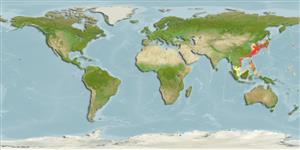Common names from other countries
Environment: milieu / climate zone / depth range / distribution range
Écologie
marin démersal; profondeur 25 - 615 m (Ref. 11230). Tropical
Northwest Pacific: southern Hokkaido, Japan southward to the South China Sea.
Taille / Poids / Âge
Maturity: Lm ? range ? - ? cm
Max length : 40.0 cm TL mâle / non sexé; (Ref. 559); poids max. publié: 950.00 g (Ref. 40637)
Description synthétique
Clés d'identification | Morphologie | Morphométrie
Rayons mous dorsaux (Total) : 15 - 17; Rayons mous anaux: 15 - 17. Lower half of the inner pectoral fin with scattered numerous pale spots (bluish in life, white or pale in preserved specimens); black blotch appears occasionally on lower inner part of pectoral fin.
Found in the tropical to warm temperate areas (Ref. 9771), in sandy or sandy mud bottom (Ref. 11230).
Life cycle and mating behavior
Maturities | Reproduction | Spawnings | Egg(s) | Fecundities | Larves
Richards, W.J., 1999. Triglidae. Gurnards, sea robins, armored gurnards, and armored sea robins. p. 2359-2363. In K.E. Carpenter and V.H. Niem (eds.) FAO species identification guide for fishery purposes. The living marine resources of the WCP. Vol. 4. Bony fishes part 2 (Mugilidae to Carangidae). FAO, Rome. (Ref. 9771)
Statut dans la liste rouge de l'IUCN (Ref. 130435)
CITES (Ref. 128078)
Not Evaluated
Menace pour l'homme
Harmless
Utilisations par l'homme
Pêcheries: commercial
Outils
Articles particuliers
Télécharger en XML
Sources Internet
Estimates based on models
Preferred temperature (Ref.
115969): 6.1 - 23.1, mean 17.9 (based on 261 cells).
Phylogenetic diversity index (Ref.
82804): PD
50 = 0.5010 [Uniqueness, from 0.5 = low to 2.0 = high].
Bayesian length-weight: a=0.00692 (0.00459 - 0.01043), b=3.06 (2.94 - 3.18), in cm Total Length, based on LWR estimates for this species & (Sub)family-body (Ref.
93245).
Niveau trophique (Ref.
69278): 3.9 ±0.7 se; based on diet studies.
Résilience (Ref.
120179): Milieu, temps minimum de doublement de population : 1,4 à 4,4 années (Preliminary K or Fecundity.).
Fishing Vulnerability (Ref.
59153): Low to moderate vulnerability (30 of 100).
